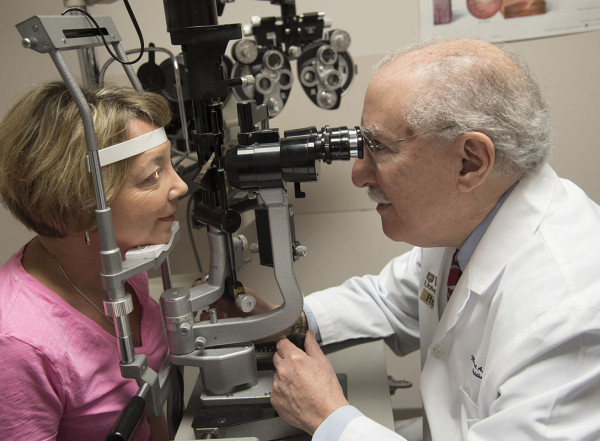Kass Lab
Michael Kass, MD, Professor, Ophthalmology and Visual Sciences


Research
Dr. Kass is the Principal Investigator of the Ocular Hypertension Treatment Study (OHTS), an NIH supported trial conducted in 22 clinical centers in the United States. OHTS was the first trial to demonstrate definitively that treatment of elevated intraocular pressure (IOP) delays or prevents the onset of glaucomatous damage. OHTS identified risk factors for developing primary open-angle glaucoma (POAG) including older age, higher IOP and larger cup/disc ratio. OHTS was the first study to identify central corneal thickness (CCT) as an independent risk factor for the development of POAG. OHTS determined that delaying treatment of ocular hypertension for several years’ results in only a small increase in the incidence of open-angle glaucoma in low-risk patients. In contrast, delaying treatment in high-risk patients substantially increases the incidence of open-angle glaucoma. We are now working to improve the prediction model by considering other potential risk factors such as axial length, perfusion pressure and optic disc size. We are also investigating genetic factors that control quantitative traits of the eye that may be linked to glaucoma including corneal thickness and intraocular pressure. The papers listed below summarize the published outcomes of OHTS.
Publications
View all Michael Kass’ NCBI publication on PubMed»
Selected or Recent Journal Articles
- Bhorade AM, Gordon MO, Wilson B, Weinreb RN, Kass MA; Ocular Hypertension Treatment Study Group. “Variability of intraocular pressure measurements in observation participants in the ocular hypertension treatment study.” Ophthalmology. 2009 Apr;116(4):717-24
- Ocular Hypertension Treatment Study Group; European Glaucoma Prevention Study Group, Gordon MO, Torri V, Miglior S, Beiser JA, Floriani I, Miller JP, Gao F, Adamsons I, Poli D, D’Agostino RB, Kass MA. “Validated prediction model for the development of primary open-angle glaucoma in individuals with ocular hypertension.” Ophthalmology. 2007 Jan;114(1):10-9.
- Kymes SM, Kass MA, Anderson DR, Miller JP, Gordon MO; Ocular Hypertension Treatment Study Group (OHTS). “Management of ocular hypertension: a cost-effectiveness approach from the Ocular Hypertension Treatment Study.” Am J Ophthalmol. 2006 Jun;141(6):997-1008.
- Gordon MO, Beiser JA, Brandt JD, Heuer DK, Higginbotham EJ, Johnson CA, Keltner JL, Miller JP, Parrish RK 2nd, Wilson MR, Kass MA. “The Ocular Hypertension Treatment Study: baseline factors that predict the onset of primary open-angle glaucoma.” Arch Ophthalmol. 2002 Jun;120(6):714-20; discussion 829-30.
- Kass MA, Heuer DK, Higginbotham EJ, Johnson CA, Keltner JL, Miller JP, Parrish RK 2nd, Wilson MR, Gordon MO. “The Ocular Hypertension Treatment Study: a randomized trial determines that topical ocular hypotensive medication delays or prevents the onset of primary open-angle glaucoma.” Arch Ophthalmol. 2002 Jun;120(6):701-13; discussion 829-30.
- Tezel G, Siegmund KD, Trinkaus K, Wax MB, Kass MA, Kolker AE. “Clinical factors associated with progression of glaucomatous optic disc damage in treated patients.”
Arch Ophthalmol. 2001 Jun;119(6):813-8. - Tezel G, Dorr D, Kolker AE, Wax MB, Kass MA. “Concordance of parapapillary chorioretinal atrophy in ocular hypertension with visual field defects that accompany glaucoma development.” Ophthalmology. 2000 Jun;107(6):1194-9.
- Gordon MO, Kass MA. “The Ocular Hypertension Treatment Study: design and baseline description of the participants.” Arch Ophthalmol. 1999 May;117(5):573-83.
- Tezel G, Kolker AE, Kass MA, Wax MB. “Late removal of releasable sutures after trabeculectomy or combined trabeculectomy with cataract extraction supplemented with antifibrotics.” J Glaucoma. 1998 Apr;7(2):75-81.
- Tezel G, Kolker AE, Wax MB, Kass MA, Gordon M, Siegmund KD. “Parapapillary chorioretinal atrophy in patients with ocular hypertension. II. An evaluation of progressive changes.” Arch Ophthalmol. 1997 Dec;115(12):1509-14.